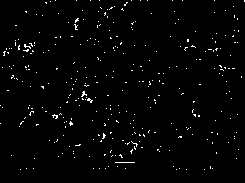A kind of zinc vanadate-molybdenum trioxide nanosheet lithium battery electrode material and preparation method
A molybdenum trioxide and electrode material technology, applied in battery electrodes, chemical instruments and methods, nanotechnology and other directions, can solve the problems of short life, large capacitance loss, volume expansion and pulverization, and achieve high efficiency and simple and easy method. to solve the effect of rapid capacity decay
- Summary
- Abstract
- Description
- Claims
- Application Information
AI Technical Summary
Problems solved by technology
Method used
Image
Examples
Embodiment 1
[0027] (1) Molybdenum disulfide is infiltrated with dilute sulfuric acid, then washed with water and dried, and expanded by high pressure to increase the interlayer distance of molybdenum disulfide and become loose molybdenum disulfide;
[0028] (2) Dissolve ammonium metavanadate and zinc acetate in a reactor with a molar ratio of 2:3 in hot water at 80-90°C, then add the prefabricated loose molybdenum disulfide in step (1), and turn on the negative vacuum pump , stirring under vacuum for 30 minutes, so that the solution of ammonium metavanadate and zinc acetate enters the interlayer of molybdenum disulfide;
[0029] (3) Raise the temperature of the reactor to 150-200°C, and control the reaction time at 45-60 minutes. The solution of ammonium metavanadate and zinc acetate uses the interlayer of molybdenum disulfide as a growth template, and forms zinc vanadate flakes along the layer space. , while maintaining a vacuum, so that the reaction by-products such as water are dischar...
Embodiment 2
[0034] (1) Soak the molybdenum disulfide with dilute sulfuric acid, then wash it with water and dry it, and expand the interlayer distance of the molybdenum disulfide to become loose molybdenum disulfide;
[0035] (2) Dissolve ammonium metavanadate and zinc acetate in hot water at 80-90°C in a reaction kettle at a molar ratio of 2:4, and then add the prefabricated loose molybdenum disulfide in step (1), loose molybdenum disulfide The dosage is 5% of the total mass of ammonium metavanadate and zinc acetate, turn on the negative vacuum pump, stir under vacuum conditions for 30min, so that the solution of ammonium metavanadate and zinc acetate enters the interlayer of molybdenum disulfide;
[0036](3) Raise the temperature of the reaction kettle to 200°C, and control the reaction time at 60 minutes. The solution of ammonium metavanadate and zinc acetate uses the interlayer of molybdenum disulfide as a growth template to form zinc vanadate flakes along the layer space while maintai...
Embodiment 3
[0041] (1) Soak the molybdenum disulfide with dilute sulfuric acid, then wash it with water and dry it, and expand the interlayer distance of the molybdenum disulfide to become loose molybdenum disulfide;
[0042] (2) Dissolve ammonium metavanadate and zinc acetate in hot water at 80-90°C in a reaction kettle at a molar ratio of 2:2, and then add the prefabricated loose molybdenum disulfide in step (1), loose molybdenum disulfide The dosage is 10% of the total mass of ammonium metavanadate and zinc acetate, turn on the negative vacuum pump, stir under vacuum conditions for 30min, make the solution of ammonium metavanadate and zinc acetate enter the interlayer of molybdenum disulfide;
[0043] (3) Raise the temperature of the reaction kettle to 200°C, and control the reaction time at 60 minutes. The solution of ammonium metavanadate and zinc acetate uses the interlayer of molybdenum disulfide as a growth template to form zinc vanadate flakes along the layer space while maintaini...
PUM
 Login to View More
Login to View More Abstract
Description
Claims
Application Information
 Login to View More
Login to View More - R&D
- Intellectual Property
- Life Sciences
- Materials
- Tech Scout
- Unparalleled Data Quality
- Higher Quality Content
- 60% Fewer Hallucinations
Browse by: Latest US Patents, China's latest patents, Technical Efficacy Thesaurus, Application Domain, Technology Topic, Popular Technical Reports.
© 2025 PatSnap. All rights reserved.Legal|Privacy policy|Modern Slavery Act Transparency Statement|Sitemap|About US| Contact US: help@patsnap.com

